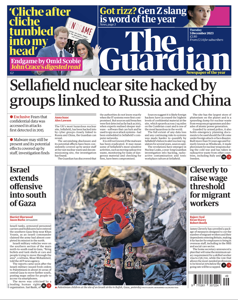
Sellafield
The Guardian
Nuclear Leaks, Guardian’s year-long investigation into security concerns at the site changed that: it forced a spotlight on the site, and revealed major security breaches, including cyberattacks linked to China and Russia, as well as toxic culture and leaks of radioactive material.
While sporadic reports on Sellafield’s culture or security had appeared in recent years, this investigation was the first of its kind - it was a year long investigation spanning security, to safety and culture, producing a series of exclusive scoops.
The investigation required huge amounts of research into technical details of nuclear infrastructure, finding a way into the secretive world of the civil nuclear constabulary - a specialist armed police force - as well as getting to grips with the shape of Sellafield’s vast array of computer servers.
The revelations sparked a probe by the then secretary of state for energy, Claire Coutinho in late 2023, and in June this year Sellafield pleaded guilty to criminal charges related to cybersecurity failings over a four year period. Much of the detail that emerged in a subsequent sentencing hearing in August underlined the dire state of Sellafield’s cyber security armoury. They reinforced its vulnerability to hostile states at a time of heightened global tension.
The National Audit Office is now examining the site’s spending and several senior staff members have been moved out of roles with nuclear material and IT security responsibilities.
The series of articles sparked a fresh public debate about the UK’s civil nuclear security, forcing into public view the years-long concerns at the heart of Whitehall and beyond about Sellafield’s critical computer systems and leaks of radioactive material to the ground.
Reporting on national security has become increasingly challenging in recent years, with little or no legal defence if the authorities decide to take issue with reporting on these topics. Anna Isaac and Alex Lawson had to set about their work weighing up these significant personal risks for themselves and, of course, their sources.
Isaac and Lawson built up dozens of interviews to illustrate not only major IT breaches but the very human toll on the many workers at the huge site, uncovering a culture of cover up, bullying and coercion. Sellafield’s insular world with problems over corporate accountability, racism among its nuclear police force and unchecked national security threats.